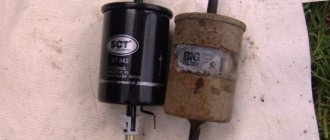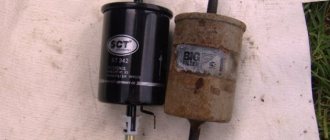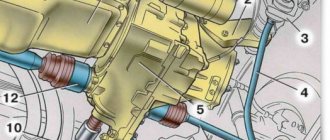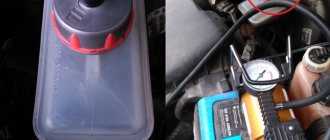The battery is an important component of any modern car. With its help, the engine starts, plus you can turn on different consumers without starting the engine. Thus, the power comes not from the generator, but from the battery.
But over time, the battery capacity may decrease. And at some point, when you turn the key in the ignition, nothing happens. Yes, car service specialists will say that the battery has reached its end, its service life has expired, and it is better to buy a new one. And they will probably tell you where and which one to buy.
But you shouldn't make hasty conclusions. A procedure such as CTC often allows you to resuscitate the battery. This is not a 100% guarantee of returning to full functionality, but a great way to save on buying a new battery. It's at least worth a try.
Why does the charge drop?
All batteries have a certain capacity, stated in Ah. In passenger cars, batteries of 60-80 Ah are most often found. That is, at 60 Ah, the device can produce a current of 1 Ampere for 60 hours. But this is in theory.
In practice, everything is different. As soon as the engine starts, the charge drops significantly. But it is compensated by the operation of the generator. Not all drivers drive a lot and often, and therefore the generator simply does not have time to replenish the entire charge. It has been proven that in most cases, cars are operated with constant undercharging.
Capacity can decrease under the influence of various factors:
- poor fastening, mechanical damage;
- electrical problems;
- violation of the integrity of electrical wiring;
- sulfation processes;
- driving around the city on short trips;
- low ambient temperature, etc.
Since most drivers drive in such conditions, it is imperative to periodically check the condition and charge of the battery.
Why is the battery draining?
Each battery has a certain capacity, which is measured in ampere-hours. That is, if the battery says that its capacity is 65 Ah, this means that the battery is capable of delivering a current of 1 ampere for 65 hours. However, in reality this is far from the case. The battery is discharged when starting the engine and operating electrical appliances, and is charged from the car generator.
This cycle is never complete, so over time the battery “gets used to” not using all the electricity accumulated in it, but only part of it.
Other factors may also influence the reduction in capacity. Among them:
- Mechanical damage. A poorly secured battery can crack, causing some of the electrolyte to leak out. Due to a strong discharge, the plates inside the battery short out and it stops working.
- Electrical fault. Too much current generated by the generator will lead to constant “boiling” of the battery. Too low will not have time to charge it completely.
- Sulfation. Inside the battery there are lead plates, which, under the influence of the acid contained in the electrolyte, begin to become covered with a white coating - lead sulfate. If this process is started, the battery will completely stop working.
- City use without additional charging. Frequent engine starts and a large number of switched on electricity consumers when driving in the urban cycle do not allow the battery to be fully charged. If you do not recharge it additionally from time to time, it will quickly fail.
- Reduced temperature. Every degree lower than +20 Celsius is minus 1% of the battery capacity. If it is -30 outside, this means that the battery can only operate at “half” of its rated power. If the old battery is partially discharged, even less so.
For these reasons, it is necessary to periodically inspect the battery.
It is important to check both the condition of the battery itself and the conductive terminals. They need to be regularly cleaned of oxides and lubricated with a special lubricant.
Concept of CTC
Now we should understand in more detail the control and training cycle for batteries, since not everyone understands what it is and why it is carried out.
The batteries used in cars are lead-acid. They differ from each other in design features, additives used, and consistency of the electrolyte used. Therefore, there are AGM batteries, gel batteries, calcium batteries, etc.
The battery life is usually indicated by the manufacturer on the device body. However, you can often see figures within 5-10 years. This period seems quite acceptable, since the prospect of changing batteries every 7-8 years is encouraging. But the stated deadlines rarely coincide with the real ones. This is due to difficult working conditions, driving with constant undercharging. This affects cars used in the city and traveling short distances. Add to this low temperatures and neglect.
To minimize the cost of purchasing a new battery, you should do everything possible to extend the life of your existing battery. For this purpose, such a procedure as the CTC is provided.
A control-training cycle is a procedure that is carried out to restore discharged and old batteries. Its meaning is to completely discharge and then charge the device.
CTC allows you to partially restore characteristics and improve battery performance. You should not count on the same 100% efficiency as it was when you purchased it. But the battery will definitely serve you for an additional 2-3 years.
The recommended frequency of CTC is 2 times a year.
Procedure for carrying out the CTC
How to desulfate your battery yourself
The control and training cycle of rechargeable batteries begins with charging. The battery should be fully charged using the charger. After this, you need to check the density of the electrolyte using a hydrometer. Its normal value is in the range of 1.27 - 1.28. If the density is higher than normal, add distilled water. The electrolyte level should be 10-15 mm above the level of the plates. If the density is below normal, it is better to replace the electrolyte with a new one.
The next stage of the battery CTC is its complete discharge. It is produced by the so-called ten-hour current. Its value is defined as 10% of the nominal battery capacity. If the battery capacity is indicated, for example, 55 A*h, then it must be discharged with a current of 55/10 = 5.5 amperes. In order to accurately adjust the current value, a rheostat must be included in the circuit. However, in the absence of it, you can use a car light bulb that is suitable in power. 5.5A*12V=66 W.
The light bulb is connected to the battery as a load, and a voltmeter is connected in parallel. The discharge level should be constantly monitored so as not to discharge the battery to zero. Some batteries may not be able to withstand too much discharge. The battery is discharged until the voltage at the terminals is 10.3 V. It cannot be discharged below.
This indicator simulates a completely discharged battery. Now its real capacity becomes clear. If, for example, 7.5 hours have passed since the start of discharge, then its real capacity is 7.5 hours * 5.5 A = 41.25 Ah. Thus, only 75% of the battery’s nominal capacity of 55 Ah remains.
The last stage of the CTC of the car battery will be to fully charge it again. Under no circumstances should you leave the battery in a discharged state, this will lead to its failure. It is recommended to carry out not one such cycle, but two or three.
Many car owners share stories that the battery has not been used for long, but the car can be started with great difficulty. Finding out what the reason is, it turns out that the electrical equipment is working properly, the relay-controller operates on time, and the operation of the generator is also satisfactory. But the battery does not accept a charge at all.
Why do you need training?
Not everyone fully understands why such training is carried out on an old or dead car battery.
There are several main reasons:
- desire to postpone the purchase of a new expensive battery;
- increasing the service life of the used battery;
- resuscitation of a battery that was forgotten and found after a long time;
- restoring the characteristics of a battery that has been in use for a long time.
In some cases, when the battery has been lying in the garage for a couple of years or they simply forgot to remove it from the car, leaving it for long-term storage without the terminals removed, it is possible to restore the battery, which seems already condemned to disposal.
Correctly carried out training of an old car battery, when charging and discharging, allows the car owner to save money. Plus, the battery will somewhat restore its characteristics, and therefore the engine will start easier even in severe frosts.
How to extend the life of a car battery?
The average service life of modern lead #8212; An acid-based car battery lasts from 5 to 7 years. This is only in that case. if the owner fulfills all the manufacturer’s requirements for maintenance and operation of the battery. It's not always possible to foresee everything. and death comes suddenly. This also applies to the battery. To avoid wasting extra money on buying a new battery
It is enough to pay attention to it literally twice a year. Then it will serve not just the required 7 years
or it may still be in stock. To do this, you need nothing at all - car battery training.
What is control #8212; training cycle?
If the battery is very tired or has not been used for a long time. Only KTC can help him - control #8212; training cycle. It will also help you get to know the battery better. which stood. let's say. on a newly purchased car. determine its approximate resource and lifespan. The whole operation is easily carried out with your own hands without complex equipment and encyclopedic knowledge. All you have to do is read this guide. and the battery can take on a new life. breathe deeply and please the owner with stable 12 V. Experienced motorists recommend training and restoring the car battery at least once a year. except for new batteries. The training cycle includes a full battery charge. control battery discharge. after which recharging is carried out.
How to conduct battery training?
All training work with the battery is not carried out in a car. To do this, remove the battery. charge using charging technology using any available charger. after which the electrolyte density is measured in all sections of the battery. The average density of the electrolyte should be within 1.27 g/cm3. Density testing is carried out with an aerometer. and some battery models have a built-in indicator. which signals the level of electrolyte density. If the density is greater than nominal. Distilled water is added to the jar. If less, the finished electrolyte has a density of 1.4 g/cm3.
Now the most important thing is to properly discharge the battery. To do this, it is connected to a powerful rheostat. and the discharge parameters are controlled with an ammeter and a voltmeter. The connection diagram is so simple. that we drew it ourselves. Here she is .
Now. when the battery is connected. the ten-hour current discharge process begins. The current value corresponds to 9% of the nominal battery capacity. That is. if the battery is 50 A.h. then the discharge current should be exactly 4.5 A. if 60 #8212; then 5.4 A. and a 75 A.h battery is discharged with a current of 6.8 A
It is very important to maintain the discharge current at a constant level until then. until the voltage at the battery terminals drops to 10
3 V. Discharge below this value is not allowed.
Subtleties of battery training
The process is quite subtle. requiring attention. but extremely effective. We record the time from the beginning of discharge. The first measurement is taken at the very beginning of the discharge cycle. it is necessary to keep an eye on this. so that the electrolyte does not overheat. Subsequent measurements are carried out no earlier. than in 3 #8212; 4 hours. Main. don't miss the moment. when the voltage drops to 11 V. After this threshold, measurements are taken every 10 #8212; 15 minutes until then. until the voltage value drops to 10. 2 #8212; 10. 3 V. Time. spent on discharging the battery with a given current. will speak volumes about the true capacity of the battery. The shorter the discharge time. the lower the actual capacity. This can be easily calculated. The discharge current is simply multiplied by the time. which is spent on discharging to 10.2 volts.
Sequence of the CTC procedure
Many people carry out CTC of old batteries at home and successfully complete the tasks.
To perform this procedure, you will need to prepare:
- Charger;
- hydrometer;
- load of the required size;
- multimeter
Self-charging your own car battery using the CTC method quite often gives a positive result. But for this it is important to strictly follow the instructions and adhere to the given sequence.
To complete the training cycle, that is, charge and discharge worn-out batteries, you should learn how to use a multimeter.
The procedure itself includes 3 stages:
- pre-charge;
- control digit;
- charge.
It is important to perform each stage correctly. If during normal maintenance you only need to discharge the battery, then with CTC of the battery you need to know to what voltage to do this and when to start the reverse action.
Preliminary calculations are carried out for a specific battery to determine the exact load.
Preliminary stage
If you delve into the essence and study all the details, then the scheme for carrying out the CTC of a car battery will not seem so complicated. Therefore, many successfully do it with their own hands.
If you have a good quality factory charger, no problems will arise. Just connect the battery to the charger and wait for the process to complete.
The voltage up to which CTC will need to be carried out depends on the specific battery and the conditions of the cycle. Therefore, study its technical characteristics.
The charge is carried out according to the density of the electrolyte located inside and according to the voltage. When precharging the battery, focus on the following values:
- A voltage of 12.72 V corresponds to a density of 1.28 and indicates a 100% charge.
- A voltage of 12.5 V says the density is 1.24 and the charge is 75%.
- At 12.35 V the density will be 1.2. In this case, the battery is charged 50%.
- If 12.1 V, then the density is low, only 1.16, and the charge is only 25%.
These parameters, as well as the use of special formulas, will be relevant when using a simplified version of the charger. It is important to calculate the exact time.
For example, measuring density with an aerometer showed 1.16 g/cm3. That is, the charge here is 25%, and its loss is correspondingly 75%. The battery itself has a capacity of 60 Ah.
To calculate the loss, the capacity should be 60 Ah multiplied by 75% and divided by 100%. We get 45 Ah.
The charging current voltage should always be no more than 10% of the battery capacity.
If you have 60 Ah, then the charging current will be 6 A.
As a result, it is easy to calculate the time required for charging. There is a formula for this: 2 multiplied by the loss of capacity and divided by the charging current.
In this case it is 2*45/6. Total 15 hours to charge.
But the calculation is approximate, since you still need to constantly monitor the density and voltage parameters. Once they reach 1.27 g/cm3 and 12.7 V respectively, the charge is complete.
We have already figured out how to pre-charge the battery.
Discharge
Read more about how to correctly and independently carry out CTC for your battery. We need to move on to the second stage. Now let's properly discharge the battery.
Oddly enough, to restore the battery's functionality after charging it, you need to completely recharge it. Only the discharge process must be strictly controlled.
When discharging a battery, be it an AGM type, the popular gel, calcium or classic lead-acid, it is necessary to create an electrical circuit in which a current consumer, a voltmeter and an ammeter will be connected.
The battery is discharged using a 10-hour current. Its value ranges from 9 to 10 of the battery capacity.
Here you should look at the instruction manual or use special tables. Here are some examples:
- for a battery with 6 banks of 50 Ah, the discharge current will be 4.5 A;
- with 6 banks, but 60 Ah, this is 5.4 A;
- if there are 12 cans and the capacity is 70, then 7 A is used;
- at 90 Ah, a discharge current of 8.1 A is required.
The discharge is carried out by an appropriate and correctly selected load. For standard car batteries with a capacity of 60 Ah, it is enough to take a 65 W bulb. The load can be calculated using the formula by multiplying the discharge current by the voltage of 12 V.
Having all the necessary tools for the battery CTC, you can begin discharging. At the same time, it is important to ensure the following conditions:
- the electrolyte temperature at the start of the discharge is in the range from 18 to 27 degrees;
- temperature and voltage checks are carried out before starting the process and then repeated at intervals of 2 hours;
- when the voltage drops to 1.85 V, the check is done every 15 minutes;
- when the voltage drops to 1.75 V, the parameters are constantly monitored;
- at a value of 1.7 V, the discharge stops and the load is turned off.
Never leave the battery discharged. You need to start recharging immediately.
Otherwise, it is unlikely that it will be possible to revive the battery.
Basic methods for restoring and training batteries
Restoring batteries using the method of long-term charging with low currents
This method is successfully used for minor and not old sulfation of battery plates. The battery is connected to charging with a normal current value (10% of the total battery capacity). Charging is carried out until gases begin to form. After which there is a break for 20 minutes. At the second stage, the battery is charged, reducing the current value to 1% of the capacity. Then take a break for 20 minutes. Repeats charging cycles several times
Restoring batteries using the method of deep discharges with low currents
To restore a battery with signs of old sulfation, a battery charging method is used with recharging with currents of normal magnitude and subsequent long-term deep discharge with low current values. By performing several cycles of strong discharge with low currents and normal charging, the battery can be successfully restored.
Restoring batteries using cyclic current charging method
The battery is tested and the internal resistance of the battery is measured. If the actual resistance exceeds the factory-set value, the battery is charged with a low current, after which a break of 5 minutes is taken and the battery begins to discharge. Take a break again and repeat the cycles “charge - break - discharge - break” many times.
Restoring batteries using pulsed currents
The essence of the method is to supply a pulsed current to charge the battery. The amplitude of the current value in pulses is 5 times higher than normal values. The maximum amplitude values can briefly reach 50 Amps. The pulse duration is short - a few microseconds. With this charging mode, lead sulfate crystals melt and the battery is restored
Restoring batteries using the constant voltage method
The essence of the method is to charge the battery with a constant voltage current, while the current strength changes (usually decreases). At the same time, at the first stage of the charging process, the current is 150% of the battery capacity and gradually decreases to low values over time
KTC (full battery charge)
The modern market is oversaturated with automatic chargers. Our company offers battery chargers of its own production, which can be purchased at a competitive price. When using such devices, the CTC procedure is much easier. Charge the battery and wait until it is fully charged. To be sure that the battery is charged, check the electrolyte level using a hydrometer.
The battery charging time is calculated using this formula.
Signs of the end of the charge: constant electrolyte density and voltage for 2 hours (temperature, as well as electrolyte density and voltage at the end of the charge are measured after an hour).
CTC (battery discharge)
To discharge the battery, it is advisable to use discharge devices. During the process, the battery voltage is periodically checked - the first measurement at the beginning, the next one after four hours.
It is important to remember that you cannot leave a discharged battery for a long time!
After the battery is discharged, you need to charge it again in the same way as in the beginning.
On average, the CTC process can take two days. It is recommended to carry out the entire CTC cycle 2-3 times.
Our company produces a range of devices for servicing batteries of all types. All products produced by our enterprise are made using high technology, which contributes to uninterrupted operation for a long time.











